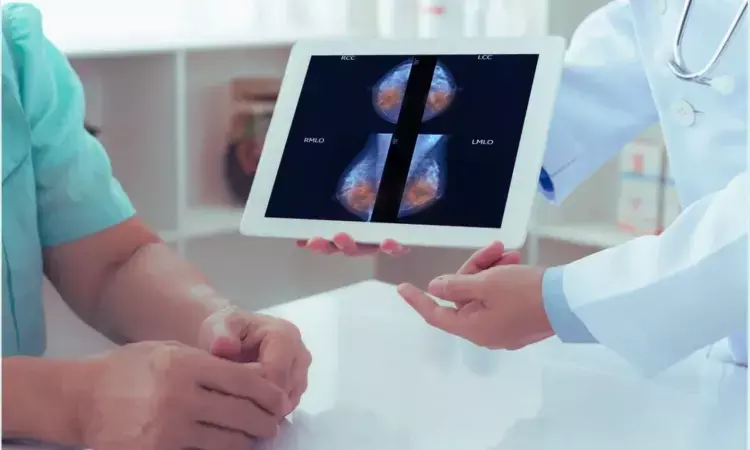- Home
- Medical news & Guidelines
- Anesthesiology
- Cardiology and CTVS
- Critical Care
- Dentistry
- Dermatology
- Diabetes and Endocrinology
- ENT
- Gastroenterology
- Medicine
- Nephrology
- Neurology
- Obstretics-Gynaecology
- Oncology
- Ophthalmology
- Orthopaedics
- Pediatrics-Neonatology
- Psychiatry
- Pulmonology
- Radiology
- Surgery
- Urology
- Laboratory Medicine
- Diet
- Nursing
- Paramedical
- Physiotherapy
- Health news
- Fact Check
- Bone Health Fact Check
- Brain Health Fact Check
- Cancer Related Fact Check
- Child Care Fact Check
- Dental and oral health fact check
- Diabetes and metabolic health fact check
- Diet and Nutrition Fact Check
- Eye and ENT Care Fact Check
- Fitness fact check
- Gut health fact check
- Heart health fact check
- Kidney health fact check
- Medical education fact check
- Men's health fact check
- Respiratory fact check
- Skin and hair care fact check
- Vaccine and Immunization fact check
- Women's health fact check
- AYUSH
- State News
- Andaman and Nicobar Islands
- Andhra Pradesh
- Arunachal Pradesh
- Assam
- Bihar
- Chandigarh
- Chattisgarh
- Dadra and Nagar Haveli
- Daman and Diu
- Delhi
- Goa
- Gujarat
- Haryana
- Himachal Pradesh
- Jammu & Kashmir
- Jharkhand
- Karnataka
- Kerala
- Ladakh
- Lakshadweep
- Madhya Pradesh
- Maharashtra
- Manipur
- Meghalaya
- Mizoram
- Nagaland
- Odisha
- Puducherry
- Punjab
- Rajasthan
- Sikkim
- Tamil Nadu
- Telangana
- Tripura
- Uttar Pradesh
- Uttrakhand
- West Bengal
- Medical Education
- Industry
AI-based CAD software enhances radiologists' performance to interpret ABUS images

A recent study has demonstrated the potential of artificial intelligence (AI)-based computer-aided detection software (CAD) to significantly improve the diagnostic performance of radiologists in detecting suspicious breast lesions through automated breast ultrasounds (ABUS). The findings suggest that AI-CAD could become a valuable diagnostic tool for improving breast cancer detection.
Breast cancer remains a significant global health concern, and early detection is crucial for improving patient outcomes. Mammography is the standard screening tool, but automated breast ultrasounds (ABUS) are increasingly utilized for breast lesion detection. The study aimed to assess the impact of AI-CAD on radiologists' performance in detecting breast lesions and reclassifying Breast Imaging Reporting and Data System (BI-RADS) categories.
This study was published in Academic Radiology by Kwon M. and colleagues. The study included 262 breast lesions detected via ABUS, with histopathological verification between January 2020 and December 2022. Two radiologists independently reviewed the images and assigned BI-RADS categories. AI-CAD software was employed to classify ABUS images as positive or negative for suspicious lesions. Four approaches were used to readjust the BI-RADS categories: radiologists modified categories based on AI results (AI-aided 1), upgraded or downgraded based on AI results (AI-aided 2), only upgraded for positive AI results (AI-aided 3), or only downgraded for negative AI results (AI-aided 4). The diagnostic performance of AI-aided approaches was compared to radiologists. Additionally, characteristics of AI-CAD-positive and AI-CAD-negative cancer cases were examined.
- The study included 262 lesions from 231 women, including 145 malignant and 117 benign cases, with a mean age of 52.2 years.
- The area under the receiver operator characteristic curve (AUC) for radiologists was 0.870 (95% confidence interval [CI], 0.832–0.908).
- AI-CAD implementation significantly improved radiologists' performance, with AI-aided 1 achieving an AUC of 0.919 (95% CI, 0.890–0.947; P = 0.001).
- AI-aided 2, 3, and 4 also demonstrated improvements in AUC, although without statistical significance.
- AI-CAD-negative cancer cases tended to be smaller, less frequently exhibited a retraction phenomenon, and had lower BI-RADS categories.
- Among non mass lesions, AI-CAD-negative cancers showed no posterior shadowing.
The study highlights the potential of AI-CAD as a powerful tool to enhance the diagnostic capabilities of radiologists in detecting breast lesions using ABUS. The implementation of AI significantly improved diagnostic performance, which could contribute to more accurate and efficient breast cancer detection. These findings offer promising prospects for the integration of AI technology in breast cancer screening and diagnosis.
Reference:
Kwon, M.-R., Youn, I., Lee, M. Y., & Lee, H.-A. Diagnostic performance of artificial intelligence–based computer-aided detection software for automated breast ultrasound. Academic Radiology,2023. https://doi.org/10.1016/j.acra.2023.09.013
Dr Riya Dave has completed dentistry from Gujarat University in 2022. She is a dentist and accomplished medical and scientific writer known for her commitment to bridging the gap between clinical expertise and accessible healthcare information. She has been actively involved in writing blogs related to health and wellness.
Dr Kamal Kant Kohli-MBBS, DTCD- a chest specialist with more than 30 years of practice and a flair for writing clinical articles, Dr Kamal Kant Kohli joined Medical Dialogues as a Chief Editor of Medical News. Besides writing articles, as an editor, he proofreads and verifies all the medical content published on Medical Dialogues including those coming from journals, studies,medical conferences,guidelines etc. Email: drkohli@medicaldialogues.in. Contact no. 011-43720751


